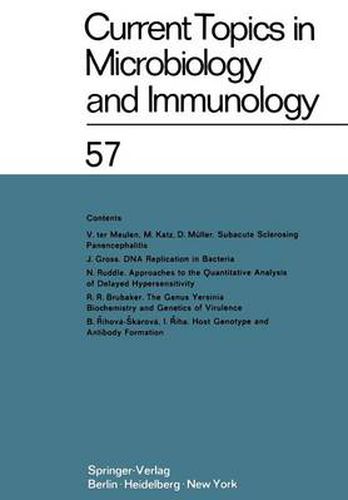Readings Newsletter
Become a Readings Member to make your shopping experience even easier.
Sign in or sign up for free!
You’re not far away from qualifying for FREE standard shipping within Australia
You’ve qualified for FREE standard shipping within Australia
The cart is loading…






This title is printed to order. This book may have been self-published. If so, we cannot guarantee the quality of the content. In the main most books will have gone through the editing process however some may not. We therefore suggest that you be aware of this before ordering this book. If in doubt check either the author or publisher’s details as we are unable to accept any returns unless they are faulty. Please contact us if you have any questions.
Phenomena as diverse as tuberculin sensitivity, delayed sensitivity to soluble proteins other than tuberculin, contact allergy, homograft rejection, experimental autoallergies, and the response to many microorganisms, have been classified as members of the class of immune reactions known as delayed or cellular hypersensitivity. Similarities in time course, histology, and absence of detectable circulating immunoglobulins characterize these cell-mediated immune reactions in vivo. The state of delayed or cellular hypersensitivity can be transferred from one animal to another by means of sensitized living lymphoid cells (CHASE, 1945; LANDSTEINER and CHASE, 1942; MITCHISON, 1954). The responsible cell has been described by GOWANS (1965) as a small lymphocyte. Passive transfer has also been achieved in the human with extracts of sensitized cells (LAWRENCE, 1959). The in vivo characteristic of delayed hypersensitivity from which the class derives its name is the delayed skin reaction. When an antigen is injected intradermally into a previously immunized animal, the typical delayed reaction begins to appear after 4 hours, reaches a peak at 24 hours, and fades after 48 hours. It is grossly characterized by induration, erythyma, and occasionally necrosis. The histology of the delayed reaction has been studied by numerous investigators (COHEN et al. , 1967; GELL and HINDE, 1951; KOSUNEN, 1966; KOSUNEN et al. , 1963; MCCLUSKEY et al. , 1963; WAKSMAN, 1960; WAKSMAN, 1962). Initially dilatation of the capillaries with exudation of fluid and cells occurs.
$9.00 standard shipping within Australia
FREE standard shipping within Australia for orders over $100.00
Express & International shipping calculated at checkout
This title is printed to order. This book may have been self-published. If so, we cannot guarantee the quality of the content. In the main most books will have gone through the editing process however some may not. We therefore suggest that you be aware of this before ordering this book. If in doubt check either the author or publisher’s details as we are unable to accept any returns unless they are faulty. Please contact us if you have any questions.
Phenomena as diverse as tuberculin sensitivity, delayed sensitivity to soluble proteins other than tuberculin, contact allergy, homograft rejection, experimental autoallergies, and the response to many microorganisms, have been classified as members of the class of immune reactions known as delayed or cellular hypersensitivity. Similarities in time course, histology, and absence of detectable circulating immunoglobulins characterize these cell-mediated immune reactions in vivo. The state of delayed or cellular hypersensitivity can be transferred from one animal to another by means of sensitized living lymphoid cells (CHASE, 1945; LANDSTEINER and CHASE, 1942; MITCHISON, 1954). The responsible cell has been described by GOWANS (1965) as a small lymphocyte. Passive transfer has also been achieved in the human with extracts of sensitized cells (LAWRENCE, 1959). The in vivo characteristic of delayed hypersensitivity from which the class derives its name is the delayed skin reaction. When an antigen is injected intradermally into a previously immunized animal, the typical delayed reaction begins to appear after 4 hours, reaches a peak at 24 hours, and fades after 48 hours. It is grossly characterized by induration, erythyma, and occasionally necrosis. The histology of the delayed reaction has been studied by numerous investigators (COHEN et al. , 1967; GELL and HINDE, 1951; KOSUNEN, 1966; KOSUNEN et al. , 1963; MCCLUSKEY et al. , 1963; WAKSMAN, 1960; WAKSMAN, 1962). Initially dilatation of the capillaries with exudation of fluid and cells occurs.